Italy's sunken city returning from the sea
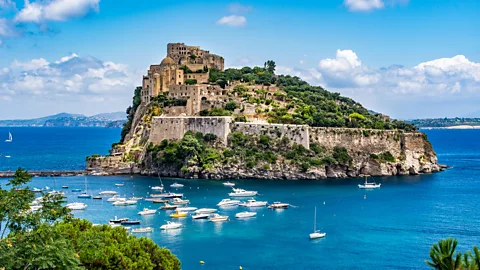 Alamy
AlamyA volcanic eruption sank Aenaria nearly 2,000 years ago. Now, underwater tours and ongoing excavations are bringing Ischia's fascinating history back to the surface.
"You're fine. Just don't look down."
I hold my breath, take the captain's outstretched hand and board the boat. The waves glimmer beneath my feet; the only thing separating me from the sea is a pane of glass.
As our tour sets sail, the vast Bay of Cartaromana opens up before us. Jagged cliffs shoot up from the waves; sunbathers sprawl on the inlet bridge leading to the 2,500-year-old Aragonese Castle, attached to the island like the tail of a whale periscoping through the waves. After just 10 minutes at sea, we reach a network of buoys marking the ruins below. I press my hands against the vessel's transparent bottom. Through the turquoise-blue water, between waving fields of seagrass and small striped fish, I glimpse a pile of rocks. Then the seagrass parts and I see that the rocks are arranged into a long rectangular form, its sides encased in wooden planks. This is an ancient city's quay; buried in the cool dark for centuries and perfectly preserved.
Ancient Rome, almost close enough to touch.
I am on the Italian island of Ischia, where sometime around AD180, the Cretaio volcano erupted, and the ensuing shockwaves sank the Roman port city of Aenaria beneath the sea.
At least, that's what archaeologists think happened. Unlike the eruption of Mount Vesuvius in AD79 – documented by Pliny the Younger in the hours before it devastated Pompeii – there are no records of the explosion, and very little written about the settlement itself.
For nearly 2,000 years, there was no physical trace of it either. The ruins lay submerged in the Bay of Cartaromana hidden for centuries beneath layers of sediment and volcanic material.
The first hints of its existence were in 1972, when two scuba divers found Roman-era pottery shards and two lead ingots off Ischia's eastern shore. The find intrigued archaeologists, but the ensuing investigation, helmed by local priest Don Pietro Monti and archaeologist Giorgio Buchner, yielded nothing. Officials cordoned off the bay. The case went cold for nearly 40 years.
Then, in 2011, passionate local sailors reopened the excavation, this time digging into the sea floor. Soon, they were able to confirm that 2m beneath the bay's volcanic seabed lay the ruins of a massive Roman-era quay. Further digs found coins, amphorae, mosaics, seaside villas and the wooden wreckage of a ship.
For centuries, Aenaria had existed somewhere between history and myth. Today, its rediscovery is reshaping Ischia's story – and offering travellers the rare chance each summer to dive into a piece of history once thought lost to the sea.
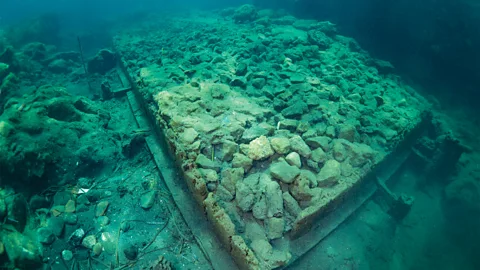 Alessandra Benini
Alessandra BeniniA puzzling past
As far as anyone had ever known, Ischia's DNA was Greek. The island was renowned as the site of the first Greek colony in the Italian peninsula, established around 750BC in the north of the island. The Greeks called the island Pithecusae and harnessed the healing powers of its volcanic thermal springs to found its first spas.
Today, with its lush beauty, laid-back vibe and revered thermal spa culture, Ischia is Italy's quintessential wellness retreat – despite sitting atop the Campi Flegrei supervolcano. But it's precisely that volatile volcanic geology that has shaped the island's verdant landscapes and wild beaches.
It's also what archaeologists long assumed had scared the Romans away from permanently settling here.
When the Romans seized Pithecusae sometime around 322BC, they renamed the island Aenaria – a name that appears in ancient texts from Pliny the Elder to Strabo, often in relation to military events. But unlike the Greeks, who left behind a necropolis, kilns and troves of pottery, the Romans left only a few modest tombs, engravings and scattered opus reticulatum. Scholars settled on the theory that they'd come to the island but never properly settled it – perhaps avoiding it due to its constant volcanic rumblings.
"The name was documented," echoes local resident Giulio Lauro. "But no one could find the place." Archaeologists had been looking for Roman Ischia on dry land, but it was buried below the sea.
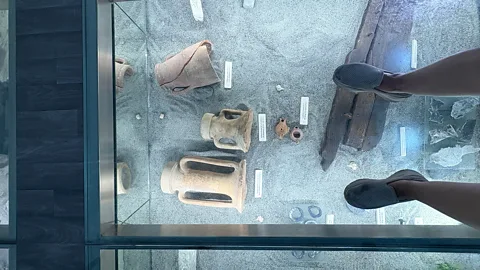 Eva Sandoval
Eva SandovalThe modern rediscovery
Lauro is the founder of the Marina di Sant'Anna; the cultural branch of the Ischia Barche sea-tourism cooperative. Along with various affiliated cultural groups – comprised of Ischian seafarers, history enthusiasts and archaeologists – they have self-funded the excavations for the past 15 years.
Lauro is quick to tell me that he's no scientist. "But I love the sea," he said. "In 2010, I got the idea to look again … People said maybe there was something there, because in the '70s they found artefacts. I thought, why not try?"
The plan was to launch underwater tours "to create a cultural attraction", says Dr Alessandra Benini, the project's lead archaeologist. "[Then] it was, 'let's see if there's truly a deeper history of our island'."
There were challenges, recalls Lauro: "Getting authorisations, training people, sourcing funds. We started from zero. We were lucky to believe in it. And then to actually find it."
Finally, the narrative could be rewritten.
"It was believed that the Romans never built a city on Ischia," says Benini. "It was the opposite."
Aenaria returned from the sea
Each day in the Bay of Cartaromana, swimmers dive off the rocks and sailboats bob in the waves. Do they know what's beneath the sea, I wonder?
"Most locals do, thanks to [the archaeologists]," says local tour guide Marianna Polverino. "But not many visitors know about Aenaria's existence, or that you can visit it."
Plan your trip:
Get there: Take the hydrofoil or the ferry from Naples to Ischia Porto, then the 7 bus to Ischia Ponte. Underwater and glass-bottomed tours of Aenaria run between May and October and are bookable here.
Stay: At La Vigna, a charming hilltop B&B, or splash out at the Aragonese Castle, which hosts a luxury hotel inside its 16th-Century convent.
Do: Have a healing soak at one of Ischia's many thermal spas; scale Monte Epomeo for sweeping views of the Gulf.
Eat: A crusty zingara sandwich at BisBoccia Bistro or a plate of spaghetti with sea urchin at the hilltop Giardino di Eden beach club overlooking the ruins.
Each summer, Benini and her team excavate the sea floor. Progress is painstaking due to a perennial shortage of funds. "They invest in Herculaneum, in Pompeii," remarks consulting archaeologist Maria Lauro, and because of the ocean's seasonal turbulence, they can only operate from May to October.
During the site's active months, curious visitors can take glass-bottomed boat tours, as well as snorkelling and scuba excursions to get even closer to the ruins. "You can see the underwater archaeologists at work, the equipment they use and everything involved," says Benini.
All tours start with viewing a 3D video in the cooperative's small auditorium, where artefacts from the site are displayed beneath glass flooring, arranged on a layer of sand evoking the seabed. My shoes tread over amphorae, oil lamps, herringbone-patterned clusters of opus spicatum tiles – a tile pattern "typically found in [Ancient] Roman shops", says Benini.
The video – featuring a submarine that winds up in a digitally reconstructed Aenaria – is geared towards children, but I'm enthralled. The quay hugs the coastline and just beyond is a Roman city resplendent with cobblestoned lanes and columned buildings. To think during the eruption nearly 2,000 years ago, someone – maybe a Roman soldier – may have been standing on that massive quay, terrified as it crumpled beneath their feet.
Benini has her own vision of that fateful day.
"There might've been a tsunami-like wave, or maybe an earthquake, that swept across the structures and pulled everything out to sea," she says. "That's the movie in our minds."
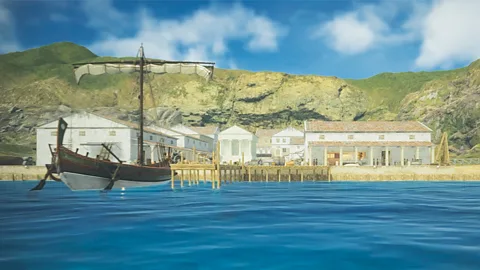 Alessandra Benini
Alessandra BeniniRewriting ancient history
Each summer, a clearer picture of Aenaria emerges – although there remains some confusion as to what the ancient settlement actually was.
Were the ruins a city? Benini explains: "[The name] Aenaria referred to the island as a whole. So it's not that we haven't found the Aenaria mentioned by the ancients: Aenaria is Ischia – that's unquestionable. We've found a Roman-era settlement with a port that was well connected to the entire Mediterranean and, presumably, had an inhabited area behind it."
Radiocarbon dating of the quay's wooden stakes puts it at roughly 75 to AD30. The discovery of the shipwreck in 2020 unearthed naval equipment, like a bronze mooring post in the shape of a swan's head – typical of Roman military vessels – as well as items like lead sling bullets, suggesting that Aenaria may have been a crucial military outpost controlling the Gulf of Naples. Recovered amphorae also suggest Aenaria's wide reach; the 142 clay variants come from 12 Mediterranean production zones, stretching from Campania to the Levant. The most recent analyses showed that the site's lead came from Spain, painting an even clearer picture of how deep Aenaria's intercultural network was.
"It's likely there was also a small town nearby [the port]," says Benini. "We found thousands of mosaic tiles, roof tiles, wooden combs for hair, needles for mending nets, decorated plaster… These aren't just ship or trade related. They suggest a residential area."
Since the initial digs, two seaside villas have been uncovered, with grand tunnel-like galleries, alcoves and traces of Roman baths.
"The ruins of Aenaria give insight into the lives of the ancient people who lived on the island," says Polverino. "It was truly the centre of trade in the Mediterranean. You understand how important Ischia was – and still is – without ever forgetting the history that lies behind it."
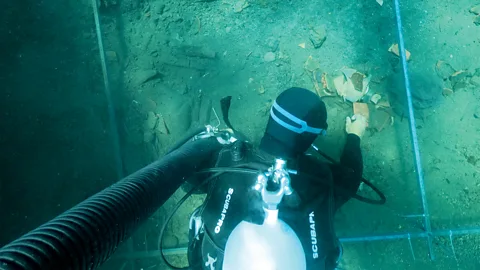 Alessandra Benini
Alessandra BeniniLooking ahead
I ask Benini what she hopes to find this summer.
"My dream is to find the foundations of the residential city," she says. "If we've found the port, then we know there was a city."
The team hopes to introduce Lidar, Georadar and sub-bottom profiler instruments into the digs, but Benini points out, "That's expensive. We need more investors."
Funding aside, the true challenge for those involved has always been reaching a wider audience: "[We are] sharing a part of Ischia's history that, until now, had been missing," says Benini.
"What we've found is 99% underwater. It's like Pompeii: until it was excavated in the 1700s, no one knew it was there. But that doesn't mean it wasn't important or didn't exist."
"We rewrote history," adds Lauro. "They gave up on finding something in the bay. But we found something."
--
If you liked this story, sign up for The Essential List newsletter – a handpicked selection of features, videos and can't-miss news, delivered to your inbox twice a week.
